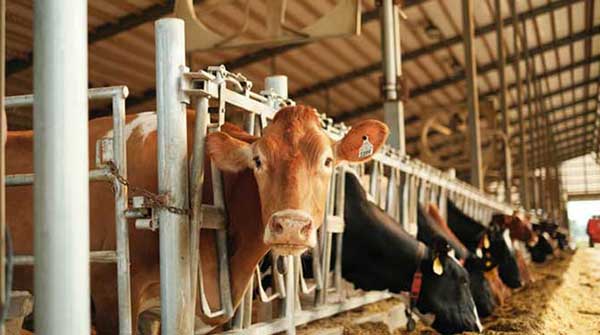Dairy farmer Jerry Huigen’s milk dumping video is representative of the dark side of our supply management system

For interview requests, click here
A video of an exasperated Canadian dairy farmer, Jerry Huigen, went viral last week. For probably the first time in Canadian history, a Canadian dairy farmer was filmed while discarding milk on his own farm. Almost three million people have now viewed that video. It shocked many Canadians, who were left wondering why this is even possible when food prices are skyrocketing at the grocery store.
The dairy industry has its reasons. Supply management, which is our government-sanctioned quota system, allows 9,500 dairy farmers to produce what we need as a country. The system is highly protected with import tariffs, and the Canadian Dairy Commission sets an appropriate price for farm milk so that farmers can make a decent living.
But dairy cows cannot magically start and stop making milk and butter fat. It just doesn’t work that way. So, most farmers will overshoot to hit their quota. Feed, the weather, and many other factors influence milk production – most Canadians can appreciate that.
| Related Stories |
| What’s really behind higher milk prices
|
| Buttergate compromises the farmer-consumer contract
|
| It’s time Canada stopped protecting its dairy industry
|
Based on rough estimates, it is believed Canadian dairy farmers can dump up to 300 million litres a year in Canada. I asked the Canadian Dairy Commission for exact figures on the amount of milk dumped, and they could not say, which is a problem in and of itself. Since the dairy industry is self-regulated but highly protected by public policy, the Commission, a crown corporation, ought to know. But transparency is hardly the dairy sector’s strong point.
In Ontario, an amendment to By-Laws for Marketing Boards under the Milk Act was made last fall, allowing the Dairy Farmers of Ontario to “list and maintain the confidentiality of commercially sensitive DFO board documents.” Similar rules affect other dairy boards across the country. The DFO did disclose the amount of wasted farm milk prior to 2022. Moving forward, that is highly unlikely to happen again.
Now, as usual, dairy advocates were quick to go on the defensive in an attempt to trivialize the issue of milk waste on the farm. The Dairy Farmers of Canada are always ready to send marching orders to those affiliated with Canada’s dairy practices. Their message always implies supporting the status quo, without saying so directly. They did the same with the “Buttergate” scandal in 2021 when it was disclosed that dairy farmers were using palm oil derivatives to feed cows, making butter harder. And they are doing it again, normalizing what is seen as completely unacceptable for Canadian consumers and taxpayers.
Milk dumping remains a highly taboo subject within the industry, which is why dairy boards do everything they possibly can to silence people and make embarrassing stories disappear. It shows the true dark side of supply management, the system farmers care very much about.
What is being missed in this debate is how supply management can actually eliminate all waste as the quota system can be used to our own advantage. Producing food only to destroy it makes no sense, especially with looming emission targets. Most dairy farmers around the world do discard milk occasionally. But Canada has the perfect system in place to eliminate all waste.
Firstly, we need to make milk dumping illegal. This policy shift will provide an incentive for farmers to adjust. Right now, dumping is the easiest thing to do: making it illegal would force marketing boards to find a market for the surplus.
Secondly, the CDC should create a strategic reserve for milk or powdered milk. Most Canadians aren’t aware that we already have a strategic reserve for butter, which includes over 85,000 kilos. Such a buffer could help between processing and shipping to markets abroad. And finally, we need processing plants.
Canadian dairy farmers have often argued that we can’t ship Canadian milk abroad; that is until China decided to build its own plant in Kingston, Ontario, called Canadian Royal Milk. That’s right, Ontario dairy farmers are supplying this Chinese-owned plant to produce baby formula, and all its products are shipped to China. We can certainly do this ourselves. All we need is to create an incentive for change.
Change for the better is possible. The first step to fixing a problem is to recognize that we have one. Meanwhile, though, many dairy advocates and academics will continue to normalize the issue of milk dumping by calling farmers like Jerry Huigen incompetent, foolish, and irresponsible. We also have zero publicly available data about farm milk waste, as we continue to pay more for milk and dairy products at the grocery store.
Huigen, with his 43 years of experience as a dairy farmer, has now delivered what Canadians deserve from the industry. Courage, transparency, accountability. This is what we need, now more than ever so we make supply management work for farmers and Canadians.
Dr. Sylvain Charlebois is senior director of the agri-food analytics lab and a professor in food distribution and policy at Dalhousie University.
For interview requests, click here.
The opinions expressed by our columnists and contributors are theirs alone and do not inherently or expressly reflect the views of our publication.
© Troy Media
Troy Media is an editorial content provider to media outlets and its own hosted community news outlets across Canada.

